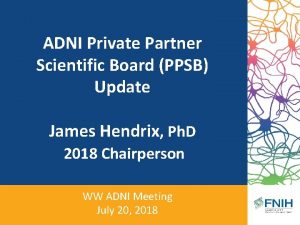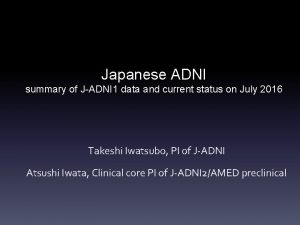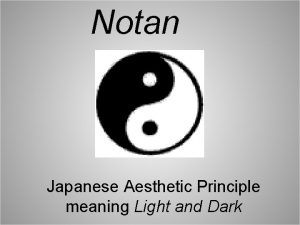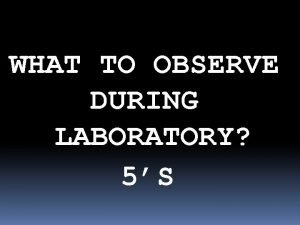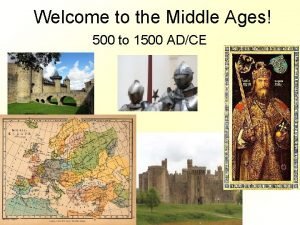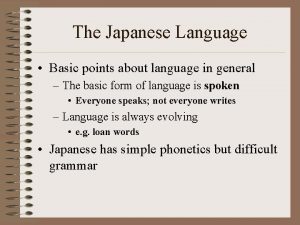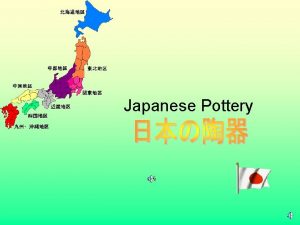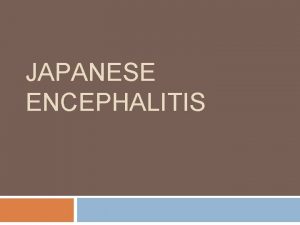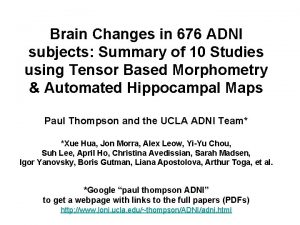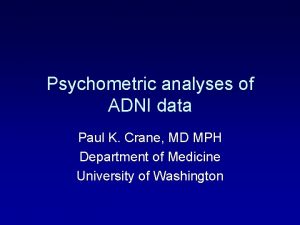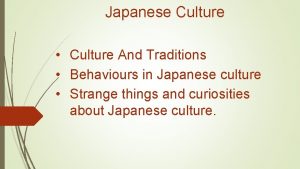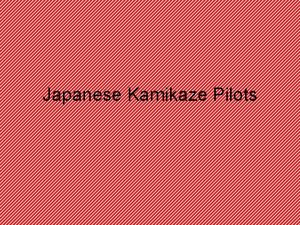Japanese ADNI summary of JADNI 1 data and

















- Slides: 17

Japanese ADNI summary of J-ADNI 1 data and current status on July 2016 Takeshi Iwatsubo, PI of J-ADNI Atsushi Iwata, Clinical core PI of J-ADNI 2/AMED preclinical

Japanese ADNI The 1 st nationwide observational early AD study in Japan Sapporo • 7 -year study (since 2007) • 38 clinical sites • Goal: 600 subjects N follow up early AD 150 (149) 2 yr MCI 300 (234) 3 yr 150(154) • 1. 5 T MRI NC (3 D MPRAGE, ADNI phantom) • PET ---FDG 67% (IC obtained) ---amyloid 42% (IC obtained) (PIB 15 sites, BF 227 2 sites) • Blood + apo. E (100%), immortalized lymphoblasts • CSF 40% (IC obtained) • Clinical (14 test batteries) 3 yr 537 finally enrolled by Apr 2013 Tottori Okayama Kagawa Fukuoka Kumamoto Hirosaki Akita Iwate Tohoku Niigata Gumma, Tsukuba, Mihara Kanazawa Shinshu NCNP Saitama Kyorin Tokyo Met Geriatric Hosp Tokyo Med col, Nippon Med, Asahi/Chiba-higashi Juntendo, TMDU, Tokyo Kyoto Natl Longev. , Hamamatsu, Kurihama, Yokohama Pref Kobe, Osaka City Osaka, Nara

J-ADNI database • Released for research use from the National Bioscience Database Center (NBDC) of JST, Japan, on Jan 29, 2016. • Please obtain approval from local ethics committee and apply to NBDC at http: //humandbs. biosciencedbc. jp/en/data-use • Total number of datasets 3691 Case Report Forms 3078 Cognitive Test Worksheets 2550 Clinical Dementia Rating 2459 1. 5 T MRI images, 256 3 T MRI images 1387 FDG PET images 594 amyloid PET images 3067 blood tests 339 CSF Ab and tau Collaborative analysis of J-ADNI/NA-ADNI initiated by Iwatsubo, Iwata, Beckett and Donohue

J-ADNI Demographics Normal controls (n=154) MCI (n=234) AD (n=149) P Age, mean (SD) 68. 3 (5. 8) 76. 4 (5. 0) 72. 8 (5. 9) 75. 3 (7. 5) 73. 6 (6. 6) 75. 8 (7. 4) <0. 0001 Female (%) 51. 9 48. 0 50. 4 35. 4 57. 0 47. 4 Years of education, mean (SD) 13. 8 (2. 8) 15. 6 (3. 1) 13. 0 (2. 8) 16. 0 (2. 9) 12. 4 (3. 1) 14. 7 (3. 1) 0. 0002 Apolipoprotein E e 4: Positive (%) 24. 0 26. 6 52. 1 53. 5 59. 6 65. 6 <0. 0001 Red: US-ADNI (WW-ADNI@Sendai, 2009)

Entry survival 100 50 0 0 6 12 18 24 36 Completion NC 89. 6% (3 y), MCI 74. 8% (3 y), AD 81. 2% (2 y)

J-ADNI Cognitive Function baseline Normal (n=154) MMSE 29. 1(1. 3) MCI (n=234) 26. 4(1. 7) AD (n=149) 22. 5(1. 8) memory Delayed recall (logical) 11. 58 (3. 52) 2. 02 (2. 09) 0. 66 (1. 15) Boston naming 28. 6 (1. 8) 27. 9 25. 6 (4. 5) 25. 5 24. 4 (4. 8) 22. 3 Category fluency total 35. 8 (7. 4) 34. 6 25. 7 (6. 7) 26. 7 21. 6 (6. 3) 20. 3 Trail A time 37. 7 (12. 6) 36. 5 56. 0 (25. 7) 44. 8 66. 7 (32. 7) 68. 2 Trail B time 101. 3 (45. 5) 89. 2 168. 2 (78. 2) 130. 5 212. 6 (79. 3) 199. 6 Digit symbol correct 65. 5 (14. 7) 45. 7 46. 8 (15. 4) 36. 9 37. 8 (14. 3) 26. 7 4. 97 (0. 18) 4. 86 4. 81 (0. 50) 4. 65 4. 60 (0. 85) 4. 31 Digit span: Forward 9. 28 (2. 11) 8. 78 9. 25 (2. 61) 8. 22 8. 17 (2. 24) 7. 54 Digit span: Backward 6. 34 (2. 03) 7. 21 5. 64 (1. 63) 6. 17 4. 78 (1. 64) 4. 96 language Executive function 120 sec (WAISIII)/90 sec (WAIS-R) Visuospatial ability Clock draw: copy Attention

MMSE individual performances in J-ADNI NC MCI AD 30 30 30 20 20 20 10 10 10 0 0 6 12 24 36 0 6 12 1824 36 MMSE decline rate NC -0. 039/yr, MCI -1. 29/yr, AD -1. 38/yr 0 6 12 24

CDR sum of boxes individual performance in J-ADNI 20 20 20 15 15 15 10 10 10 5 5 5 0 0 6 12 24 36 0 6 121824 36 0 6 12 NC 0. 04/yr, MCI 1. 08/yr, AD 1. 28/yr 24

ADAS-cog 11 trend in J-ADNI NC MCI AD 50 50 50 40 40 40 30 30 30 20 20 20 10 10 10 0 0 6 12 24 36 0 0 6 121824 36 0 0 6 12 24 NC: -0. 09/yr, MCI +1. 93/yr, AD: +2. 11/yr

Conversion rate NC to MCI 100 1 year conversion rate 1. 3% 2 year conversion rate 2. 6% 3 year conversion rate 4. 5% 50 0 0 6 12 18 24 36 MCI to AD 100 1 year conversion 26. 2% (16. 1% in US-ADNI 1) 2 year conversion 41. 5% 3 year conversion 52. 1% 50 0 0 6 12 18 24 36

MCI to AD conversion by PET amyloid positivity 100 80 17. 9% 60 40 55. 6% 20 0 0 6 12 18 24 36 Conversion rate negative 6. 0%/yr, positive 18. 5%/yr

MCI MMSE by Ab pathology MCI without Aβ biomarker 30 20 MCI with pos Aβ biomarker 10 0 0 12 24 36 MCI with pos Aβ biomarker -1. 43/yr MCI with neg Aβ biomarker -0. 14/yr

MCI CDR SOB by Ab pathology 10 8 MCI with pos Aβ biomarker 6 4 MCI without Aβ biomarker 2 0 0 12 24 MCI with pos Aβ biomarker 1. 13/yrr MCI without Aβ biomarker 0. 29/yr 36

Pi. B-PET in J-ADNI mc. SUVR and Pi. B(+)vity by Group and Apo. E 4 ε 4 ε 4+ 24% 8% 55% 24% ε 4 - ε 4+ 93% ε 4 - ε 4+ by Visual Reads 66% 41% 100% 84% 65% 90%100% by mc. SUVR cut off Kenji Ishii, amyloid PET core of J-ADNI Co-plot of mc. SUVR of Pi. B and CSF Ab(1 -42) アミロイドPET陽性は脳脊髄液 Aβ(1 -42)低値とよく一致 (髄液でもPETでも診断可能)

3 -year change in preclinical Alzheimer Cognitive Composite (PACC) in Japanese elderly based on J-ADNI 1 data (Donohue, Iwata and Iwatsubo)

J-ADNI 2/AMED preclinical AD Study (PI Hiroshi Mori, Osaka City U) J-ADNI 2/preclinical Normal Preclinical AD early MCI late Failure of DMT trials in AD dementia AD • Consists of two observational studies: (1)Preclinical AD (n=150) screened by amyloid PET, 3 -y follow up (2) early (n=100) /late MCI (n=100) studies using protocols compatible to NA ADNI 2/3; implementing FCSRT, E-Cog • ~30 clinical sites, totally covered by 11 C-Pi. B, florbetapir or flutemetamol, at ~25 PET centers nationwide • 3 T MRI (including resting f. MRI, ASL, DTI) • CSF examination at baseline, 12 M and 36 M • Towards successful clinical trials of DMTs in prodromal/preclinical AD; setting the basis for Trial Ready Cohort, providing data/mechanism for “funnel” to select at risk individuals for AD

J-DCS (Japanese Dementia Clinical study Support organization) toward trials for disease modifying therapies and establishing Trial Ready Cohort funded by AMED 2016 -2020 Model Clinical Studies JADNI 2/AMED preclinical DIAN-J observational J-DCS Osaka City Univ Data registration A 4 study JADNI 2/AMED preclinical providing support to clinical studies and trials on AD/dementia Clinical study operation center Study Management The Univ Tokyo Support analysis Project management database PI Mike Weiner International Collaboration Public Private Partnership The Univ Tokyo Imaging MRI: NCNP PET: IBRI Data management Cloud DB (CS square) The Univ Tokyo Biomarkers Pharma-sponsored clinical trials Sperling Bateman Aisen GAP TRC PAD/ JPAD int’l risk algorithm WG Iwata Iwatsubo Osaka City Univ Cognitive scales The Univ Tokyo Trial Ready Cohort QMS Niigata biosample repository The Univ Tokyo Risk evaluation funnel study support Patient Registries (IROOP-NCNP, Orange Platform-NCGG) Participation in multicenter studies certification Network of ~40 clinical sites through J-ADNI and J-ADNI 2/preclinical AD studies
 Adni james
Adni james J-adni
J-adni Jadni nemir
Jadni nemir Anime#
Anime# Philippine opera
Philippine opera Dark japanese aesthetic
Dark japanese aesthetic Japanese militarists political movements and beliefs
Japanese militarists political movements and beliefs Japanese militarists political movements and beliefs
Japanese militarists political movements and beliefs Seiton pronunciation
Seiton pronunciation A cottage in the lane poem
A cottage in the lane poem Feudalism and manorialism venn diagram
Feudalism and manorialism venn diagram Political movement and beliefs japanese militarists
Political movement and beliefs japanese militarists Winter holidays japan
Winter holidays japan Visualizing japanese grammar
Visualizing japanese grammar What is japanese word which means harbour waves
What is japanese word which means harbour waves Fruit pyramid
Fruit pyramid Language japanese
Language japanese The japanese have always loved
The japanese have always loved
